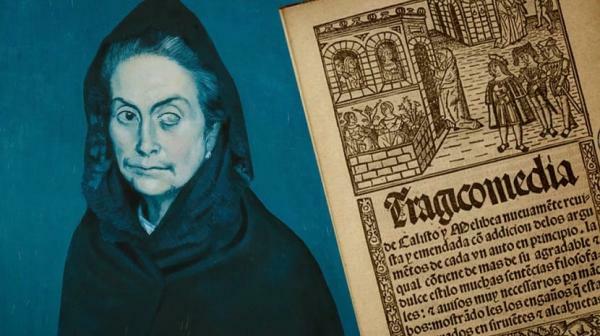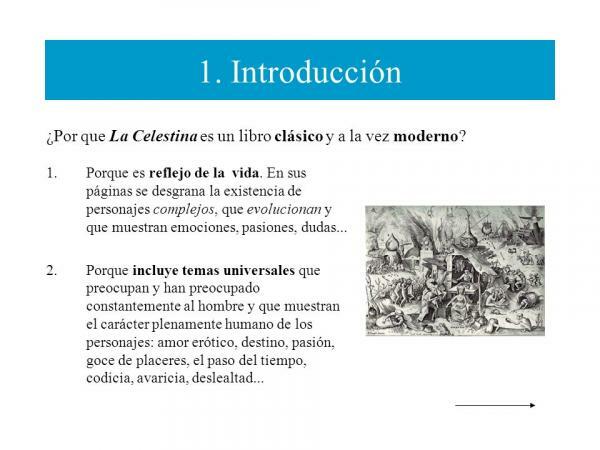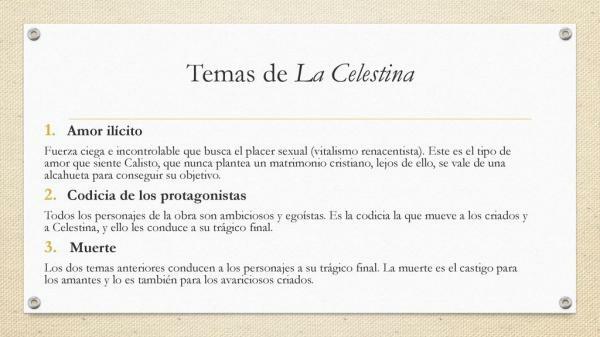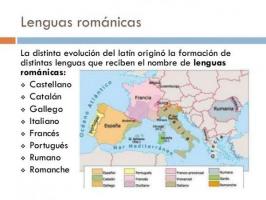MOST IMPORTANT TOPICS of La Celestina

Image: Current Literature
One of the top works of Spanish literature is La Celestina, a piece finished by Fernando de Rojas which presents an unforgettable love story starring Calisto and Melibea. One of the most studied works in both schools and universities for being a sample of the social change that was taking place. living at the time and in which the medieval forms were being overcome to replace them with a more open and modern. In this lesson from a TEACHER we are going to do a analysis of the themes of La Celestina that appear more prominently so that you can delve deeper into this literary work. We started!
Index
- Brief introduction to La Celestina
- Love, one of the most outstanding themes of La Celestina
- The greed of money, another very present theme in La Celestina
- Death
- Secondary themes of La Celestina
Brief introduction to La Celestina.
Before starting to analyze the topics of La CelestinaIt is important that we talk about the work so that we briefly remember the piece on which we are going to work. One of the reasons why this text is so important and studied in the history of our literature is because it is a work that shows the
transition that was lived between the forms of the Middle Ages and those of the Renaissance. It is, therefore, a somewhat hybrid work where we can find the influence of both aesthetics and traditions.It is important to note that although Fernando de Rojas he concluded with the writing of this story, the truth is that the first text It was written by an anonymous author. This caused that the work was published in different years and that it had significant changes depending on the author who I will finish it: on the one hand we have La Celestina as a comedy, a 16-act play that constitutes the first version; on the other hand we have the Tragicomedy (finished by Rojas), a work of 21 acts and that presents a better concocted plot and with a tragic ending.
Rojas indicated that he found the original version of the comedy without specifying the authorship of the text. He decided to finish the work and complete it, with it, he changed the genre of it, gave it a most tragic touch and defined a more complex and credible love story. Even today it is not known exactly what were the changes that Rojas made in the original text, however what we have Of course, by changing the title to "tragicomedy", he changed the genre and gave it a tragic touch that the initial comedy did not contained.
Characteristics of La Celestina
The argument of La Celestina it is presented in the text through dialogue. There is no narrator but, directly, the characters take the voice in this work, therefore, there is a protagonism of the dialogue and the monologue throughout the pages. When the characters take the word, the language used here is that of the citizens of the 16th century: a mixture between cultured and popular language depending on the social class of the character who was talking. This gives an immense expressive richness to the work, as well as a maximum likelihood that allows us to better understand the nature of each character.
The plot revolves around the crazy love that Calisto begins to feel for Melibea, a young noblewoman who does not pay attention to him. To try to conquer the lady, Calisto will have the services of Celestina, a procurer who has knowledge of witchcraft and who will bewitch the young woman so that she falls madly in love with Callisto. But the girl's father will oppose this love and the two lovers must try to overcome all obstacles to live their love with total freedom.
The contribution of Fernando de Rojas in the reissue of La Celestina has a moral and educational contribution, as the author himself indicates in the introduction. His goal was to show all the dangers that love can cause to people, a crazy, irrational and uncontrollable love that can cause real misfortunes in families.

Image: SlidePlayer
Love, one of the most outstanding themes of La Celestina.
But let's get down to business now and talk about the themes of La Celestina. The most important of which the work speaks is, of course, the love theme. This is the central theme of this piece but, on this occasion, it is presented in a different way than it had been previously presented: the crazy love, the dangerous love, the love that can lead to the greatest misfortune.
The ailments of love can be seen throughout the play, for example, the moment Calisto meets Melibea, after the meeting he will fall ill and will not feel well at all. In addition, it is a feeling that makes people behave in an unseemly way and that they stop taking morality and norms into account to indulge in lust and passionate love.
The love Sick is the main theme of La Celestina, a type of love very different from the one that normally appeared in the literature and that can seriously harm the health and lives of people who suffer from it. Calisto does not fall in love with Melibea: he becomes obsessed with her, to such an extent that he even opts for the services of a witchy pimp who will bewitch the young woman.

Image: Slideshare
The greed for money, another very present theme in La Celestina.
But, in addition to love, in La Celestina there are also other themes that have a very relevant importance. This is the case of the issue of greed for money since this desire is what gets Celestina and the servants end up helping Callisto. That is, if this character had not had money to satisfy greed, nothing that is explained in the play would have taken place.
Celestina presents herself as a very greedy woman. In fact, her greed reaches such a point that it produces the anger of the servants that they will end up murdering her. Therefore, Celestina's greed causes her own death. But the same happens with the servants: by killing the pimp they will try to flee from justice and, it will be then, when they die.
Therefore, the feeling of greed that is present in the characters of the lowest social stratum will end their own lives.
Death.
We cannot forget another of La Celestina's themes that are present in the tragicomedy version written by Fernando de Rojas. In this work, the most of the characters end up dyingTherefore, we are facing a very tragic and connoted outcome.
And at this point is when we find a major change in perspective between the Middle Ages and the Renaissance. In medieval times death was considered an act of liberation, an essential stage in order to reach heavenly life. However, this is not the approach to death that we see in La Celestina: the characters seem to advocate more for the idea of "carpe diem"In other words, living in the present and death is presented as a tragic end, not as the beginning of a new life.
The presence of death in life is what stimulates the characters to live intensely each day of their lives, which makes them get carried away by passion and emotions. Therefore, death is what originates life.

Image: SlidePlayer
Secondary themes of La Celestina.
And to finish this lesson with the main themes of La Celestina we must now talk about other secondary themes that are present in the work. Above all we can talk about two: the brujeria and fortune.
- First of all, the witchcraft she was a practice typical of the Middle Ages and, as we well know, women who considered themselves witches were hunted down and killed. The dark ages of the Middle Ages also have their mark on La Celestina, but now the witch who presents us the author is a different witch: a witch who acts as a procurer and whose main motor of interest is the money. We are, therefore, in front of a more "modern" witch who is out of the medieval imagination.
- On the other hand, the issue of fortune It is also very present in La Celestina. All the characters consider fortune to be like a uncontrollable force of life, something from which no one can run or hide. Fortune is already predetermined and, therefore, as much as the characters try to change their luck, they cannot do it because they do not have that power. This explains the pessimistic tone that is so present in the text and in the characters.

Image: Slideshare
If you want to read more articles similar to La Celestina Themes, we recommend that you enter our category of History of Literature.
Bibliography
- Maravall, J. A., & Alonso, D. (1964). The social world of "La Celestina" (pp. 27-49). Madrid: Gredos.
- Bautista, F. (2008). Social reality and ideology in "La Celestina". Celestinesca, 37-50.
- De Rojas, F. (1996). The matchmaker (Vol. 12). AKAL editions.



